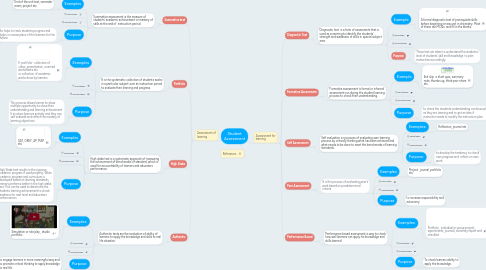
1. Assessment of learning
1.1. Summative test
1.1.1. Summative assessment is the measure of students' academic achievement or mastery of skills at the and of instruction period.
1.1.1.1. Examples
1.1.1.1.1. End of the unit test, semester exam, project etc
1.1.1.2. Advantages
1.1.1.3. Disadvantages
1.1.1.4. Purpose
1.1.1.4.1. Its helps to track students progress and helps in course place of the learners for the future.
1.2. Portfolio
1.2.1. It is the systematic collection of students works in a particular subject over an instruction period to evaluate their learning and progress.
1.2.1.1. Examples
1.2.1.1.1. E-portfolio- collection of video, presentation, scanned worksheets etc. or collection of academic works done by learners
1.2.1.2. Advantages
1.2.1.3. Disadvantages
1.2.1.4. Purpose
1.2.1.4.1. This process allows learner to show multiple opportunity to show their understanding and learning achievement. It involves learners actively and they can self evaluate and reflect the mastery of learning objectives.
1.3. High Stake
1.3.1. High stake test is a systematic approach of measuring the achievement of benchmarks of standard, which is used for accountability of learners and educators performance.
1.3.1.1. Examples
1.3.1.1.1. SAT, GREY, AP, MAP etc
1.3.1.2. Advantages
1.3.1.3. Disadvanatges
1.3.1.4. Purpose
1.3.1.4.1. High Stake test results in the rigorous academic program if used properly. When academic program and curriculum is developed based on learning standards, learners performs better in the high stake test. This can be used to determine the students learning achievement to check readiness for next level and educators performances.
1.4. Authentic
1.4.1. Authentic tests are the evaluation of ability of learners to apply the knowledge and skills to real life situation.
1.4.1.1. Examples:
1.4.1.1.1. Simulation or role play , studio portfolio
1.4.1.2. Advantages
1.4.1.3. Disadvantages
1.4.1.4. Purpose:
1.4.1.4.1. to engage learners in more meaningful way and to promote critical thinking to apply knowledge to real life.
2. Reference:
3. Assessment for learning
3.1. Diagnostic Test
3.1.1. Diagnostic test is a form of assessment that is used as screening to identify the students' strength and weakness of skills in special subject area.
3.1.1.1. Example
3.1.1.1.1. A formal diagnostic test of prerequisite skills before beginning a new unit in chemistry. Most of these are MCQs and fill in the blanks.
3.1.1.2. Advantage:
3.1.1.3. Disadvantage
3.1.1.4. Purpose
3.1.1.4.1. These test are taken to understand the academic level of students' skill and knowledge to plan instruction accordingly.
3.2. Formative Assessment
3.2.1. Formative assessment is formal or informal assessment run during the student learning process to check their understanding.
3.2.1.1. Example
3.2.1.1.1. Exit slip: a short quiz, summary note, thumbs up, think-pair-share etc.
3.2.1.2. Advantange
3.2.1.3. Disadavantage
3.2.1.4. Purpose
3.2.1.4.1. to check the students understanding continuously as they are learning and to get an idea if instructor needs to modify the instruction plan.
3.3. Self Assessment
3.3.1. Self evaluation is a process of evaluating own learning process by critically thinking what has been achieved and what needs to be done to meet the benchmarks of learning standards.
3.3.1.1. Examples:
3.3.1.1.1. Reflection, journal etc
3.3.1.2. Advantages:
3.3.1.3. Disadvantages
3.3.1.4. Purpose:
3.3.1.4.1. to develop the tendency to check own progress and reflect on own work.
3.4. Peer Assessment
3.4.1. It is the process of evaluating peer's work based on predetermined criteria
3.4.1.1. Examples
3.4.1.1.1. Project , journal, portfolio etc
3.4.1.2. Advanatges
3.4.1.3. Disadvantages
3.4.1.4. Purpose
3.4.1.4.1. to increase responsibility and autonomy.
3.5. Performance Based
3.5.1. Performance based assessment is way to check how well learners can apply his knowledge and skills learned.
3.5.1.1. Examples:
3.5.1.1.1. Portfolio , individual or group project, experiments, journals, summary report and checklist
3.5.1.2. Advantages
3.5.1.3. Disadvantages
3.5.1.4. Purpose
3.5.1.4.1. To check learners ability to apply the knowledge.
